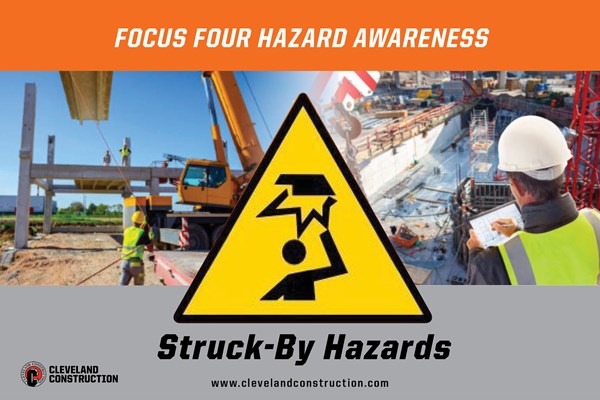
Struck-by hazards are one of the leading causes of injuries and deaths in the construction industry. The frequency and fatality rate for this type of injury has earned it a place on OSHA’s “Fatal Four” list of most deadly hazards in the industry, along with falls, electrocutions, and being caught in or between hazards. Struck-bys are the second leading type of fatalities on job sites.
Most struck-by injuries are caused by one or more of the “Big Bad Four: flying, falling, swinging, and rolling:
1. Struck-by flying objects – includes anything being thrown, hurled, or propelled across space and striking a worker.
Construction work creates a lot of potential for flying objects, airborne debris, or stray particles from drilling, grinding, or demolition. Pieces of material can separate from a tool, machine, or other equipment and strike a worker, resulting in an injury or fatality. Tips could fly off a saw blade. An object could be ejected under power by a nail gun or other tools or equipment.
In fact, accidental nail gun discharges are one of the most common causes of this hazard. These power-actuated tools are designed to go through wood, concrete, and steel. Traveling great distances, they certainly can go through a worker standing downrange or nearby!
Workers should remain alert to their surroundings at all times, avoiding areas where nail guns are being used. They must be properly trained in the use of power tools. Inspections should be done regularly on the tools to ensure they are operating properly. Proper PPE must be worn while using it. This could include safety glasses, goggles, or a face mask. Hard hats should be worn by all employees on the job site.
2. Struck-by falling objects – harm can be caused by tools and materials being knocked off unprotected edges, to rigging failure, to a suspended load on a crane coming loose and falling on a worker. It is important to note that some 96% of struck-by construction nonfatal injuries are from falling objects.
Workers should tether tools to work belts, not leave them lying on walkways or rails. All materials must be secured before lifting to prevent them from shifting or slipping. Likewise, equipment should be stacked properly to avoid tipping over and falling. Workers should avoid standing under materials stacked overhead. Proper PPE should be worn at all times, including safety glasses, face shields, goggles, and hard hats.
3. Struck-by swinging objects - Heavy equipment arms, attachments, and materials being swung around by a machine can hit workers. The swing loads of heavy equipment from cranes and derricks could pose significant struck-by hazards.
Workers should be aware of potential swinging objects. They should always be on the watch for hooks, lines, buckets, or other attachments that are swinging freely, as each poses a potential hazard. Authorized workers should enter a swinging zone only after notifying the equipment operator. Others should keep out. Weather conditions should be considered by equipment operators when moving loads, as extreme wind increases the risk of swinging hazards. Operators should inspect cranes and hoists daily to see that all components, such as wire rope, lifting hooks, and chains, are in good condition. They should not exceed the lifting capacity of the crane or hoist.
4. Struck-by rolling objects – Rolling objects or objects that move in a circular motion can cause injury to workers. A worker can be struck or even run over by a moving vehicle or struck by sliding objects or equipment. Stacked materials have the potential to collapse, then roll, if not secured properly. Workers should always watch for materials, equipment, or machinery that could become rolling objects such as pipes, reels, rebar, coils, barrels, tires, wheels, or even vehicles. They should always walk behind moving equipment, if possible. Those operating the moving equipment must never obstruct their own vision by overloading, taking extra caution around corners and near doorways. Workers must always make eye contact with the operator before approaching large equipment that is in operation.
Employer’s role in reducing struck-by accidents · Ongoing training should be provided to help workers understand best practices to avoid struck-by injuries, including certifications on all equipment/tools, proper loading/lifting techniques, and using the necessary safety gear. · Employers have the responsibility to ensure OSHA regulations are followed, specifically those related to such things as safety nets, canopies, and toe boards to prevent objects from falling from overhead levels to lower-level work sites. OSHA requires that employers provide employees with the proper PPE to prevent struck-by hazards. While requirements vary by the type of work being done and the hazards workers are exposed to, all PPE, from steel-toed boots to hard hats and protective eyewear, should meet ANSI standards. Damaged or worn-out equipment must be replaced immediately. Employers (Construction supervisors) are responsible for alerting workers to areas of potential danger for struck-by hazards.
While construction companies may always have to guard against the “Fatal Four” hazards, following simple tips and staying current with OSHA safety regulations will go a long way toward protecting workers from the dangers of struck-by injuries.
OSHA has identified the most frequent causes of Construction Worker deaths and injuries – they are called the Focus Four: Falls – Struck-by – Caught-in/-between – Electrocution.
Cleveland Construction is discussing each of these hazards on our jobsites to raise awareness on worker safety. This article is part 2 of 4 discussing OSHA's Focus Four.